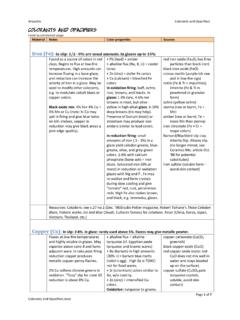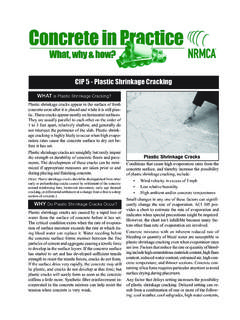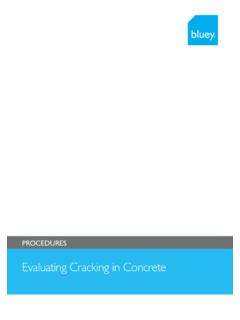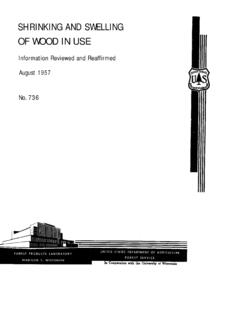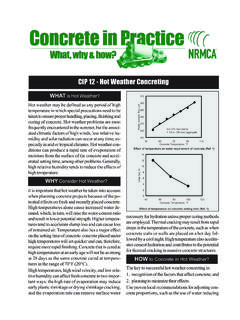Transcription of Clays and Clay Bodies - Linda Arbuckle Ceramics
1 Arbuckle Clays and clay Bodies Clays AND clay Bodies . The Nature of clay clay is a product of the decomposition of granite rock. 75% of the earth's crust is made of ALUMINA and SILICA, two of the major constituents of clay . Granite decomposes into FELDSPAR, the most common mineral, which is composed of ALUMINA, SILICA, and FLUX (of an alkaline nature sodium, potassium, lithium, calcium). The flux is somewhat soluble, and over long periods of weathering is carried off by moisture. The remaining alumina and silica are refractory (resistant to heat) and chemically inert. After long exposure to moisture, the alumina and silica become hydrated (water chemically added) to produce clay .
2 This takes long periods of geologic time and cannot be synthesized. clay is 14% chemical water. Unfired clay also contains physical water, which evaporates during drying. Stages of green (unfired) clay from most to least water: slip, plastic clay , leather hard clay , bone dry greenware. Especially in humid climates, even bone dry greenware contains some physical water. Factors that contribute to the plasticity of clay : theoretical formula for clay : plate like particle shape of particles size of the particles chemical/electrical attraction between particles presence of carbonaceous (organic) matter PLASTICITY is the ability of clay to respond to pressure with a continuous and permanent change of shape in any direction without breaking apart, and hold that shape when released.
3 Daniel Rhodes says that clay is unique in its degree of plasticity. Factors that contribute to the plasticity of clay are the PLATE LIKE PARTICLE SHAPE of clay (provides large surface area), the SIZE OF THE PARTICLES (small particles are more plastic than large ones), CHEMICAL/ELECTRICAL ATTRACTION between particles (adding an electrolyte, deflocculant such as soda ash or sodium silicate, will reduce the attraction between particles and reduce plasticity and .good in casting slip, difficult to work in plastic forming methods. (See THIXOTROPIC clay in Glen Nelson's Ceramics : A POTTER'S HANDBOOK), and PRESENCE OF CARBONACEOUS (ORGANIC) MATTER (small amounts are helpful; too much produces a sticky clay that is hard to work and has high shrinkage ).)
4 clay that lacks plasticity (a SHORT clay ) will not bend well and tends to break instead of forming when bent. A classic test is to roll a coil of clay the thickness of a pencil and see if you can wrap it around your finger w/o breaking. Short Clays lack plasticity, but will shrink less than more plastic Clays . A clay can be too plastic (A FAT clay ), and will feel sticky/slick. A fat clay generally slumps easily when thrown, and tends to have cracking problems in drying. Types of clay PRIMARY clay , or RESIDUAL clay is clay is formed at the site of the parent rock. It is less common than SECONDARY (TRANSPORTED OR SEDIMENTARY) clay , but generally whiter, free from impurities.
5 Because this clay is broken down by ground water, etc. and not transported, particle size is mixed (no opportunity for sorting or grinding) and the clay is usually not very plastic, and are refractory. Most KAOLINS are primary Clays . SECONDARY clay has been transported from multiple sources by water (alluvial), or wind (aeolian), which sort particle sizes, or by glacier (glacial), which may grind but has uneven particle sizes. Many secondary Clays contain organic (carbonaceous) and other impurities (iron, quartz, mica, etc.). Some of the more plastic kaolins are secondary Clays . Other secondary Clays : BALL clay , STONEWARE clay , FIRECLAY, EARTHENWARE clay , SLIP Clays , VOLCANIC Clays .
6 Page 1 of 7 Arbuckle Clays and clay Bodies Categories and Brands of Clays (items in bold are usually in stock here) Kaolin is named from the Chinese "kao" (high) and "ling" (hill), where it was discovered. Synonymous with CHINA clay . Pure, white burning, refractory (vitrifies at cone 34), generally non plastic primary clay with larger particle size, although sedimentary kaolins like Grolleg, Tile 6 and Georgia Kaolin, and some Florida kaolins are more plastic and finer in particle size (with resulting higher shrinkage ) than non plastic kaolins. Plastic kaolin (higher shrinkage ): EPK Edgar Plastic Kaolin. Florida kaolin. Yellowish tinge (in oxidation) when fired due to iron and titanium traces.
7 Dry shrinkage , cone 04 shrinkage 10% cone 10 reduction 17% shrinkage . Limited plasticity, in spite of its name. Not as white as Tile 6. GROLLEG Satiny, like kaolin and ball clay . Imported from England & more expensive than domestic kaolins. iron. Can be used as a slip w/the addition of a little flux. White firing. Dry shrinkage 5%, cone 04 shrinkage 7%, cone 10 reduction 17% shrinkage . PIONEER Georgia kaolin. Slightly less plastic than Tile 6 with slightly more iron. TILE 6 Also known as Six Tile clay , a Georgia kaolin. Fires slightly creamy (in oxidation) due to iron and titanium impurities. Cheaper substitute for Grolleg. A good kaolin for porcelain formulation. 16 18% shrinkage .
8 Less plastic kaolins all have less shrinkage than plastic kaolins: ENGLISH CHINA clay , KINGSLEY Type of clay Brand names *= no longer available AVERY creamy, primary Carolina kaolin. Kaolins: plastic kaolins: non plastic kaolins: Blushes orange as a wash in salt and wood EPK Avery* firing. 15% shrinkage . Limited supply: USE Grolleg China clay FOR WASHES/SLIP FOR SALT AND WOOD Pioneer Georgia Kaolin ONLY. Tile #6 Glomax (calcined kaolin) GEORGIA KAOLIN. Dry shrinkage 6%, cone Kaopaque 20 04 shrinkage 9%, cone 10 reduction 15% Ball Clays C&C OM4 shrinkage . iron. KT1 Tennessee KAOPAQUE 20. a delaminated aluminum SPG XX Sagger silicate from Georgia Kaolin. Fire Clays AP Green Carbondale Red CALCINED KAOLIN trade name GLOMAX, Cedar Hts.
9 Bonding Hawthrone Bond has been heated to red heat (CALCINED) to Pine Lake PBX Valentine* remove chemically combined water: XX Sagger "preshrunk" for reduced shrinkage in bisque slips. Stoneware Clays Cedar Hts. GoldArt Foundry Hill Cr me Jordan* Lizella Ocmulgee* Ball clay Earthenware Clays Calvert Lizella was named for the practice of rolling the Cedar Hts. RedArt Ocmulgee* very plastic clay into balls during mining. A Newman Red Ranger Red secondary (transported) clay with Slip Clays Albany Slip* Barnard* carbonaceous additions that color it grey, Alberta Slip Blackbird brown, or tan in the raw state, and fires to a light tone. More iron than kaolins, less than fire Clays .
10 Less refractory than kaolins due to more iron and smaller particle size. This small particle size gives highest shrinkage (up to 20%) and plasticity of all Clays . Too plastic to be used alone. Increases green (dry) strength. Sometimes used as a glaze ingredient to add strength to the raw glaze coat. Matures in the cone 10 12 range. Maximum amount of ball clay for a "white" body is usually not more than 15% (the exception is some lowfire whiteware Bodies ). TENNESSEE BALL, SPG BALL lightest burning ball Clays . 14 16% shrinkage . KENTUCKY OM4 (Old Mine 4) 16 18% shrinkage . 1% iron more iron than Tennessee & SPG. KT1 C&C BALL similar to OM4 but lighter in color. Page 2 of 7 Arbuckle Clays and clay Bodies Fireclays are secondary Clays with large particle size (thus low shrinkage ), good resistance to heat, more iron than ball Clays , firing buff to brown.

